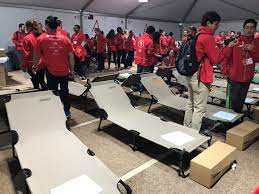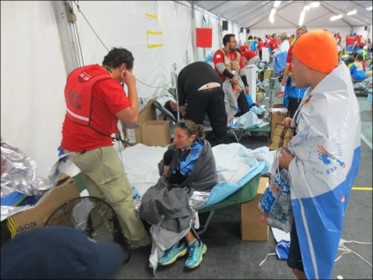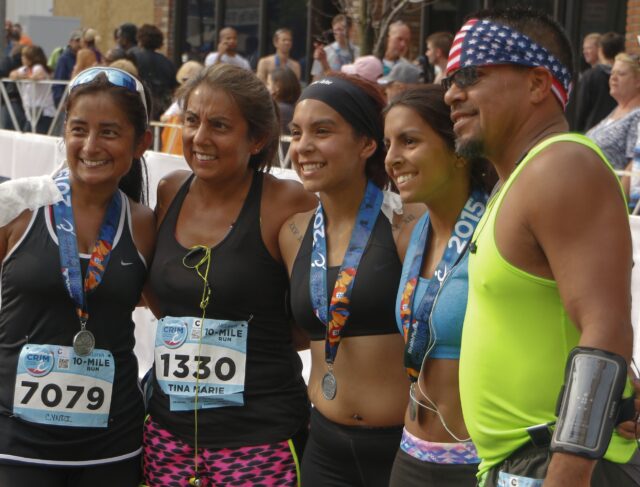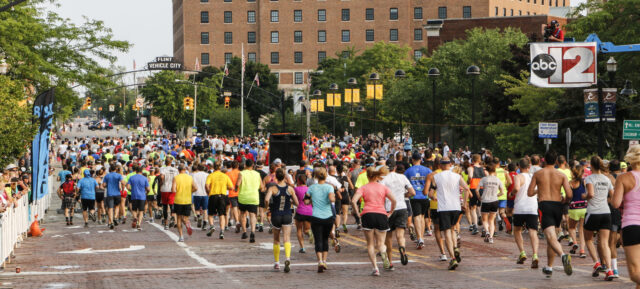by Kelly O’Mara
The finish line and sidelines of a running race can sometimes look a little bit like medical chaos: people throwing up, bent over, some laying on the ground or stumbling around. Of course, the vast majority of those athletes don’t end up in the medical tent, they’re just tired or overexerted.
But, some of the runners do need medical help and a small number will need very serious medical assistance. Every race director needs to be prepared with a medical plan and an awareness of the most common medical issues.
As a general rule of thumb, said Chris Troyanos, ATC, the long-time medical coordinator for the Boston Marathon, the medical surge capacity of a race will be about 1-2% of field size, meaning the largest number of athletes needing medical help at one time. That number will be higher, though, if the race is hotter or longer. Marathons, on average, see medical encounters of about 2% of the field.
Weather is the biggest factor in determining how many athletes will need medical assistance, with the rate of medical encounters more than doubling in “hot” years and the number of heat-related issues skyrocketing, according to Dr. William Roberts, the medical director for the Twin Cities Marathon, as defined by the WetBulb Globe Temperature, which takes into account humidity and direct heat stress. (What constitutes hot can depend on seasonable weather and how acclimated the athlete population is, and how long the distance is.) Over 69 degrees on the WetBulb Globe Temperature can be medically problematic for something as long as marathon.
No matter the size or climate of the race, though, there are best practices to prepare for what is, essentially, a controlled medical disaster. You know there will be issues, you’re just implementing plans and procedures to control and prepare for the most serious of them.
Common medical issues you need to be prepared for
The absolute most common issues runners come into medical tents for—both on-course and post-finish—are typically musculoskeletal and soft tissue, GI, or heat-related. That means blisters, cuts, cramps, strains, joint pain, nausea, bloating, and GI distress. Various analysis of multiple races has found that these account for a large number of medical encounters.
However, both Roberts and Troyanos noted that the more important things to be prepared for, rather than just the most frequent complaint, are the most common serious medical issues. These are the things, beyond blisters and muscle cramps, that every race has to absolutely plan for.
Exercise associated collapse
According to Roberts, our understanding of what is called exercise associated collapse has evolved over the years. This phenomenon when runners are unable to stand up after finishing a race is not actually likely to be caused by dehydration; it’s now considered to be a result of postural hypotension. What that means is that your legs operate as a kind of heart when running, Williams explained, with large muscles pumping blood throughout your body. When you stop, they’re no longer doing that and the accompanying drop in blood pressure can cause that post-finish collapse.
In Roberts’ tracking of medical encounters at the Twin Cities Marathon, over 26 years, nearly 90% of non-musculoskeletal or skin issues were exercise associated collapse (accounting for nearly 60% of total encounters). It is the most common medical condition at race finish lines.
For every cardiac arrest he’s had to deal with, said Roberts, he’s probably seen 10 exertion heat strokes and maybe 2,000-3,000 exercise associated collapse.
The key thing to know about exercise associated collapse is that it’s important to rule out any more serious issue causing the collapse, such as exertional heat stroke. This is where a medical professional is key to evaluating the athlete, talking to them to ensure that they’re conscious and coherent, and then establishing a protocol. Most athletes who find themselves unable to stand just need to put their feet up and give themselves a little time.
Exertional heat stroke
The next most common medical issue at the end of a race is heat-related, with various events finding heat-related issues to account for 20-30% of medical encounters. But exertional heat stroke is the most serious of those conditions, when an athlete’s core body temperature has risen above 104-105 degrees F and does not come down. Exertional heat stroke can typically be noted by disorientation and incoherence, dizziness and collapse, nausea, and of course a heightened temperature. Both Roberts and Troyanos note it’s necessary to have a rectal temperature taken in the medical tent in order to diagnose and treat these cases.
In an analysis of 100,000 runners across 10K road races, 600 medical encounters occurred with 25% of them being heat-related and 94 requiring ice tube water immersion for exertional heat stroke. In Williams’ tracking of Twin Cities Marathon data over 26 years, they had 3,269 medical encounters with about 30 severe exertional heat stroke—meaning a core rectal temperature of over 109 degrees F—and four heat stroke transfers to the hospital.
Treating heat stroke requires cooling the athlete, either through ice tub immersion or a rotating system of ice cold wet towels that are changed when they get warm and ice packs. Setting up a plan to deal with heat stroke is an absolutely necessary best practice when preparing a medical plan.
Exercised induced hyponaetremia
Hyponaetremia is the next most common serious medical issue, with the Twin Cities Marathon numbers accounting for two severe and three more mild cases over the 26 years. Asymptomatic mild EAH has been found to actually have an incidence of up to 12-13% of marathon runners, when blood levels were tested, but it’s the symptomatic EAH you need to worry about.
Hyponaetremia is when blood sodium levels fall below 135mmol/L. This can be extremely serious if sodium serum levels fall too low and can be especially serious if symptoms are mistaken for dehydration and more water is consumed, further dropping sodium levels.
Most frequently this occurs in athletes, as EAH, because of over-hydration, and a common symptom to observe would be weight gain because of the inability to urinate out or sweat excess fluid. However, the symptoms of EAH can be as mild as nausea, dizziness, and a headache, and can progress to altered mental states and seizures. Medical best practice would be to have a way to test serum sodium levels in the med tent at large events, otherwise medical personnel will have to rely on symptomatic case assessments. If the athlete is able to keep food down, then treatment in most cases would be consumption of salty food and high-sodium concentrated broths, but if an athlete is overly nauseous or symptoms are serious, then a hypertonic saline solution may be necessary.
Anaphylaxis
While relatively rare, anaphylaxis—an extreme allergic reaction—can be life-threatening. If a runner goes into anaphylactic shock from a bee string, for example, as the most common allergic reaction on a race course, then it can cause cardiac or respiratory arrest. Having epinephrine on hand can be life-saving in these instances.
Cardiac arrest
Although cardiac arrest is not very common, said Roberts, and typically happens at a rate of just one per every 50-100,000 runners, when it does happen it’s the most serious medical emergency you can have.
“Even the small races need to be prepared for that,” said Troyanos. That means having an automated external defibrillator on hand, with a paramedic or EMT who can properly administer it, and a plan for how to quickly get that AED to the person in cardiac arrest. (Find planning best practices here.)
Preparing for the most common and most serious medical issues you’re likely to see at a running race mean investing time and money into the key medical equipment and resources, having medical personnel on hand, and establishing a plan in the event one or all of these things happen.
About the Author
 Kelly O’Mara is the former editor-in-chief of Triathlete Magazine and the founder of the Triathlonish
Kelly O’Mara is the former editor-in-chief of Triathlete Magazine and the founder of the Triathlonish




